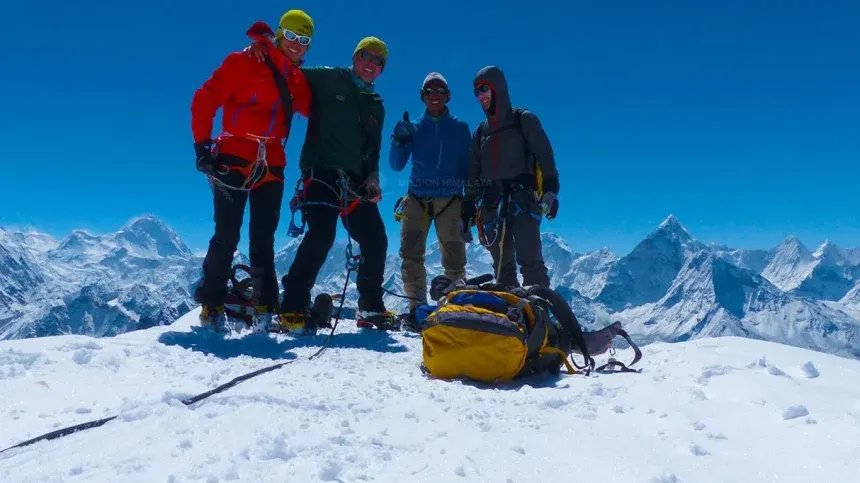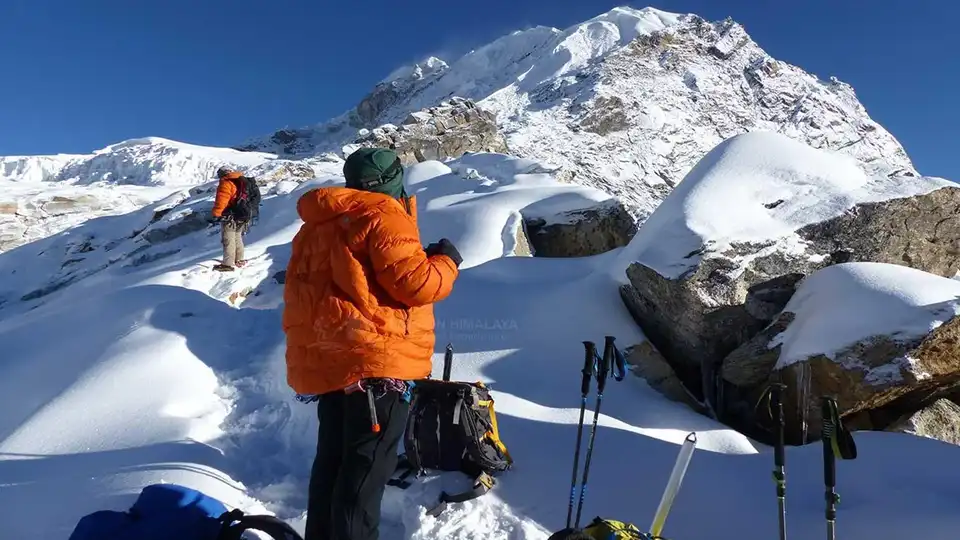Especially, Nepal is a country known for the existence of the Himalayas. In the Himalayas, people can witness numerous peaks and mountains, and among those numerous peaks and mountains, there are only a handful of peaks and mountains that can be scaled by a climber. So in this blog, we are going to discuss the Lobuche east peak difficulty, which is one of the most trending topics of the handful of peaks of the Himalayas. It is one of the prominent peaks of the Himalayas and stands out as a popular option for peak climbing along with Island peak climbing and Mera peak climbing in the Everest region. So now let’s dive straight into the topic-
How hard is Lobuche East?
Standing at the staggering height of 6119m, Lobuche East Peak is situated on the north side of Khumbu above the Lobuche village. Since the opening of the peak for climbing by the government, it has been able to garner plenty of climbers from all around the globe.
From beginners to advanced, this peak has welcomed every kind of climber. As per the feedback of both kinds of climbers till now, we have seen that experienced climbers find this peak relatively easy, whereas beginners have found this peak hard to climb in the later sections. However, being a less technical and uncomplicated peak, people eventually choose this peak to do the climb.
- Lobuche East Peak Climbing Hard?
As we now talk about the Lobuche East peak difficulty, we want to mention that climbing this peak without any preparation can result in fatal consequences. Especially, beginner climbers have to pay attention to every detail and prepare accordingly. In this climbing journey, a climber has to spend a total of 16 active days in the journey. In these 16 days, a climber has passed through different types of paths to complete the round trip. While walking through these paths, climbers have to face different kinds of difficulties.
Difficulties you may face while climbing Lobuche East Peak:
Getting Over the Tough Trails:
Trekking/climbing on the journey to Lobuche East Peak involves lots of difficulty as the paths are steep and full of rugged terrain. Trekkers must carefully maneuver through rocky surfaces, testing their physical and mental strength.
The trail’s inclines and uneven surfaces make this part of the journey an exciting adventure, demanding trekkers’ resilience and determination.
Tackling the Long Days:
Trekking up Lobuche East Peak requires lengthy, strenuous days of walking, therefore it isn’t recommended for the faint of heart. Since trekkers cover large distances every day, they need to pace themselves to avoid exhaustion and preserve energy levels. Long days of trekking not only add to the overall sense of fulfillment but also present a significant physical and mental strain. Therefore, those who want to pursue this journey need to have a great amount of stamina.
Altitude:
Another major contributing aspect to the difficulty of the Lobuche East Peak climbing is its altitude of. Climbers are exposed to high altitudes as the peak is located in the Everest region, so there is the possibility of suffering from altitude-related problems such as acute mountain sickness (AMS). Therefore, because of its great elevation, Lobuche East is a challenging trekking peak that requires careful selection of the itinerary and plan.
Weather Difficulties:
The weather can be one of the most variable obstacles on the Lobuche East Peak climb. As you know the Himalayan region is well known for its unpredictable weather, which ranges from clear skies to sudden snowstorms. Therefore, to cooperate with these kinds of environments, trekkers need to prepare well by wearing layered clothing and weatherproof gear since they must deal with the continuous changes in temperature and visibility.
Accommodation Challenges Along the Trail:
One special set of difficulties on the Lobuche East Peak climbing is to find accommodation. As trekkers reach higher elevations, there are fewer options for shelter, and the standard of services can change. Therefore, in these far-off places, finding acceptable lodging needs ideal preparation as well as a bit of adaptability.
Reaching the top:
Usually, the ascent starts with a trek to the Everest Base Camp. Then, the path will take a route that will lead you to the Lobuche Base Camp. From Base camp, climbers encounter steeper and more technically challenging terrain as they get closer to the summit. From here, the climb involves climbing ice slopes, navigating crevasses, and traveling across glacial terrain. Now telling you this, you must now know how hard it is to climb Lobuche East Peak.
Expert Advice on Lobuche East Peak Difficulty:
Insights from Tashi Sherpa:
When considering the challenge of climbing Lobuche Peak, it’s essential to heed the insights of our experienced mountaineer Tashi Sherpa. Tashi’s wealth of experience in the Himalayas has always provided valuable guidance to aspiring climbers. So here’s what he explained to us-
Respecting the Terrain:
Tashi stresses that one must show respect for the landscape, particularly for the rough and steep trails. He counsels trekkers/climbers to concentrate on keeping a moderate pace, applying appropriate trekking methods, and being aware of the constantly shifting terrain. He said that a successful climb requires taking caution and consideration of the environment before approaching the ascent.
Endurance matters:
Tashi asserts that climbing Lobuche Peak requires both technical proficiency and mental and physical stamina. He said that “trekking requires a resilient mindset and a well-paced approach over extended periods”. So, to make sure climbers are sufficiently prepared for the lengthy journey, he has advised to include stamina-building workouts in pre-trek preparations.
Weather Knowledge:
Tashi emphasizes how important it is to comprehend the Himalayan region’s unpredictable weather and make necessary adjustments. He suggests keeping up with weather forecasts and packing adequately for the variety of climates you’ll be in. He also claimed that “To handle unforeseen changes and enable climbers to make well-informed decisions while trekking, itinerary flexibility is essential”.
Awareness of Accommodations:
Tashi Sherpa emphasizes how crucial it is to keep in mind potential accommodations issues when trekking/climbing. He gives climbers three pieces of advice: make advance plans, be adaptable when choosing a place to stay, and keep an optimistic outlook on the natural appeal of Himalayan tea houses. Therefore lastly, Tashi said that embracing the unique experience of staying in these remote accommodations is an integral part of the overall adventure.
To sum up, Tashi Sherpa’s guidance on climbing Lobuche Peak centers on thorough planning. Climbers can improve their chances of a successful and satisfying ascent on this peak. For that, they should be aware of the weather, build endurance, respect the terrain, and choose accommodations wisely.
Conclusion:
Lastly, we want to tell you that a climbing adventure will always offer some difficulties. But, if you are heading for it, you have to face and overcome that difficulty anyway. In the case of the Lobuche climbing, we have listed the potential difficulties you could face on this journey. Further with the help of our expert Mr. Tashi Sherpa, we also managed to sort out the solutions to those difficulties and finally presented them to you. So, we hope that you will keep those things in mind and follow those things while you head out for the Lobuche peak climbing journey. Best of luck!









